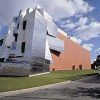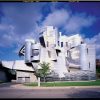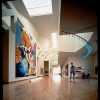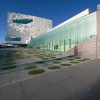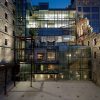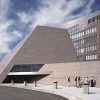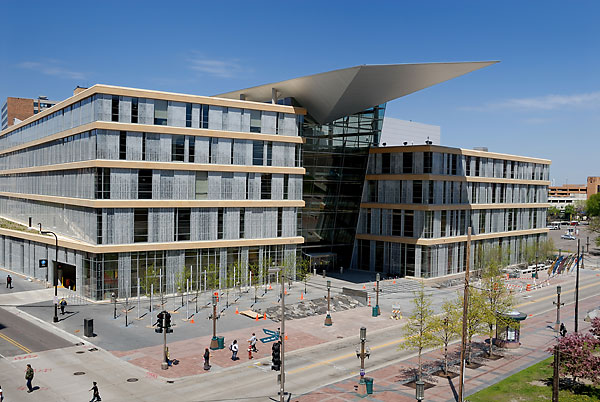
In the search for the next hotbed of modern architecture, few would think of Minneapolis. The rest would be missing out.
Minneapolis’ architecture can be, at times, far from conservative. Some of the most interesting and challenging designs can be found on the campus of the University of Minnesota. Jutting angles and unconventional footprints are common to both Antoine Predock’s McNamara Alumni Center and Frank Gehry’s Weisman Art Museum.
The McNamara Alumni Center, built as the gateway to the university, consists of two parts. The most distinctive is a rock-like structure resembling a fractured geode rising up from beneath the surface. The building is clad in granite and wood with star-shaped windows creating fissures across the surface. In contrast, the tall, slanted modern office section is covered with ample windows and copper intended to represents cliffs.
If the Guggenheim is a symphony, the Weisman is free jazz. The stainless steel jutting spires and chunky blocks are cobbled together to create the city’s most unique building. The Weisman Art Gallery is the only Gehry-designed art museum in the United States and helped to establish the daring style for which he has become famous. In a surprisingly rare move, the museum selected Gehry to design an 11,000-square-foot expansion in 2007.
The Walker Art Center is on a 17-acre urban campus that includes both buildings and parks. In 2005, an expansion designed by Herzog & de Meuron doubled the museum’s size and added new galleries, a Wolfgang Puck restaurant and a 385-seat theater. The expansion allowed for additional programming in visual and performing arts, film and video, design and new media, as well as educational and community programs.
The Walker is also home to one of Minneapolis’ most popular art destinations, the Minneapolis Sculpture Garden. The Sculpture Garden is the largest of its kind in any city in the United States, and is home to the Spoon Bridge and Cherry—the most emblematic symbol of Minneapolis. This is one of the best destinations for a sunny day in Minneapolis, no matter the season.
One of Minneapolis’ most recently globally acclaimed architectural landmarks is the Guthrie Theater designed by French architect Jean Nouvel. In 2006, after years of demand from Minneapolitan arts patrons, the Guthrie was finally given a building worthy to house the world-class theater productions it puts on every year. The Guthrie Theater is a fitting venue for the caliber of performances that are put on by this theatre company. The building was built to be inviting all passersby at any time of day. By far the best way to take advantage of this part of the Guthrie’s mission is to stand on the Endless Bridge, a platform that extends 178 feet out the rear of the Guthrie. The Endless Bridge offers plenty of seating and a panoramic view of Mississippi River, the historic Grain Belt Beer neon sign, the Mill City Museum and the Stone Arch Bridge.
Minneapolis owes much of its history to the flour milling industry. To celebrate the milling heritage, the Washburn Mill, originally built in 1880, was saved by the city after a fire in 1991 nearly destroyed it. The Mill City Museum, designed by local architect Thomas Meyer, is a concept that married the historic ruins with a modern eight-story glass façade. Meyer’s design left the original mill intact where possible, including the engine house, rail corridor and wheat house. A large, open-air courtyard showcases the ruins framed by the weathered masonry walls and the reflective glass façade.
The Foshay Tower, Minneapolis’ oldest skyscraper, stands as the most prominent in a handful of monuments left to this city’s architectural past. While its matte limestone exterior is dwarfed and outshone by the bright glass and steel giants that surround it, the Foshay is getting a 21st-century interior redesign from W Hotels. By August 2008, what was once an old office building will be 230 high-end hotel rooms in the heart of Minneapolis.
Chambers Hotel is another option. The Chambers’ fun, European-style black and white minimalism extends to the design only. Amply spacious rooms, high technology throughout and a kitchen that seats nearly 200 will make any guest comfortable. Located in the Hennepin Avenue Theater District, the Chambers is within a pleasant walk of the bars and clubs in the Warehouse District, theatre productions, countless art museums and music venues.
One thing the Minneapolis tourist should keep in mind while roaming the city’s streets is that not every building is a tourist destination: the new Minneapolis Central Library and the MacPhail Center for Music are two of many examples of architecture in Minneapolis with nothing for the tourist but appreciation of yet another thought-provoking masterpiece.
The new Minneapolis Central Library was designed by Cesar Pelli to enhance the urban character of the city and reflect the civic pride of the residents, as well as the city’s commitment to knowledge, education and literacy. A steel truss roof that cantilevers out like a giant wing over the entrance highlights the glass façade of the building. The library was designed with many green aspects including an under floor ventilation system and a green roof planted with low-growing, sun and drought resistant ground cover.
The MacPhail Center for Music, once considered the Juilliard of the Midwest, started out as a violin school in 1907. Earlier this year, the old school opened a new state-of-the-art center designed by Gehry protégé James Dayton. The new facility features a 225-seat performance hall, an outdoor plaza and a glass-walled penthouse studio for jazz and rock music classes. MacPhail is more than a school, it’s a venue; the newest part of the artistic fabric of Minneapolis.
From its early beginnings as a flourmill center, Minneapolis has evolved into a culturally rich city, boasting museums and cultural centers designed by world-renowned architects. Who knew?

